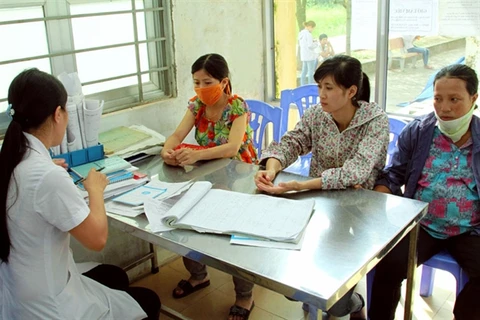Hanoi (VNA) – Thirty-three localities across the nation experienced a high fertility rate, most of which are disadvantaged areas, according to the Ministry of Health’s General Office for Population and Family Planning.
The north-central province of Ha Tinh topped the list with 2.9 children per woman of reproductive age. Northern Lai Chau province came second with 2.83 children, followed by northern Yen Bai province with 2.82 and north-central Quang Tri province with 2.8.
Among the country’s 63 provinces and cities, 21 had a low to very low fertility rate, the health ministry stated, adding that these localities are mainly located in Vietnam’s southern, central, and Mekong Delta regions. These regions are home to approximately 38 million people, and a low fertility rate over a long period of time will lead to many negative consequences.
Ho Chi Minh City ranked last in terms of fertility rate in the Southeast Asian country, with only 1.35 children born per woman of reproductive age, followed by the Mekong Delta province of Dong Thap with 1.55 and the southern province of Ba Ria-Vung Tau with 1.57.
Meanwhile, nine localities, namely Hanoi, Ninh Thuan, Quang Ninh, Lam Dong, Binh Dinh, Phu Yen, Tra Vinh, Binh Phuoc, and Hai Phong, have achieved replacement level fertility.
Replacement level fertility is the level of fertility at which a population exactly replaces itself from one generation to the next.
High fertility rate has put pressure on socio-economic development, job generation, public healthcare and education. Meanwhile, low birth rate has resulted in ageing population and shortage of workhands, and had critical impacts on social welfare, according to deputy head of the ministry’s Department of Population – Family Planning Mai Trung Son.
In 2006, Vietnam achieved its target that each couple have 2.1 children on average - the desired fertility at replacement level, 10 years earlier than the target in Resolution No.4 of the Party Central Committee dated January 14, 1993. The previous population boom was successfully contained while the population structure improved.
In 2007, the country entered the period of a golden population – an important opportunity for the country to accelerate its socio-economic development and to improve the quality of life of its population. More importantly, population density between regions has been re-distributed for the better.
Good family planning work has greatly contributed to the country’s socio-economic achievements as well as the national programme on poverty reduction and betterment of people’s livelihood.
On average, the number of children a Vietnamese woman has reduced from 3.74 children in 1992 to 2.09 children in 2006 and the same rate has been maintained until now. This is good news for Vietnam as we have been able to maintain replacement fertility level for more than 12 years.
However, the country needs to make adjustments as fertility rates vary by region, the health ministry said.
General Director of the General Office for Population and Family Planning Nguyen Doan Tu said the population sector must adjust the birth rate, work to maintain the replacement fertility level, and reduce birth rate disparity among localities.
Earlier, Prime Minister Nguyen Xuan Phuc approved a birth rate adjustment programme toward 2030 which encourages people to get married before the age of 30 and women to give birth to their second child before they reach 35.
Couples who have two children will have their income tax reduced and be assisted with their children’s tuition fees or expenses to rent houses or buy social housing.
Children from those families will have priority in admission to public schools.
In the six months since the plan’s approval, some localities, such as Ho Chi Minh City, have carried out even more targeted plans to gradually settle the issue while others have yet to begin implementing the programme.
However, Son affirmed that all the 63 cities and provinces cannot make use of a single programme for population growth due to differences in requirements for child care.
He insisted that families in localities with low living conditions reduce their birth rates to the country’s replacement level, those that have achieved the replacement level maintain their figures, and more developed localities with low fertility rate encourage families to have two children each./.
























